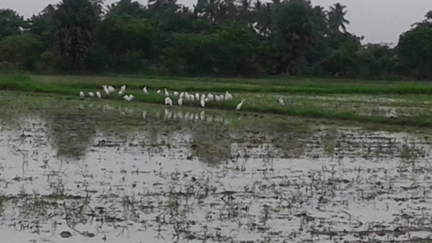Birds in Full Swing Controlling Pests
-K Amina Bibi
Karaikal (Puducherry) region lies in the tail end of Cauvery Delta. Main source of irrigation is river water by Canal system. Karaikal is known as the Paddy Belt of Union Territory of Puducherry. Cultivation of Paddy is the major crop of Kariakal. The
clay type of soil facilitates the Paddy cultivation in this area.
Paddy fields are seen to have a minimum of 5 cm standing water for most period of time. In recent days, Systematic Rice Intensification method advocated minimum water. The land is ploughed and puddled in standing water. Puddling helps in getting a soft,
leveled field which is conductive to the establishment of a good paddy crop. Then the seedlings raised in nursery are transplanted. When puddling is done, the larva of various pests hidden at subsurface level is brought to the topsoil. During this step of
land preparation, some use tractor or rotavator to puddle and prepare the main field for transplantation. The role of birds in this stage plays a crucial role to decide the level of pesticide to be used at various stages of the crop till harvest.
Paddy crop is highly infested by insect pests. Insect load of the previous season leaves behind their eggs in the weeds (in the bunds around the field) or larval stage in the subsurface level of soil which gains momentum during the successive crop which
becomes conducive for its multiplication. Birds act promptly by feeding on the grubs or larval stage of insects. Birds reach the paddy ecosystem in right time from various places at the time if post harvest (to feed on the leftover grain and insects of the
previous crop) and at the time of main field preparation (which coincides which with pre-monsoon season) – this climate is favourable for the breeding of birds. Yes, wetlands are breeding ground for many birds.

Population of birds reveals the environmental quality of the field, pollution (chemical load of the field) level and availability of grains, insects or rodents, their food. Birds feed on left over grains in the field, fruits in the nearby areas like bunds
or trees nearby. Availability of shelters for birds acts as a short term shelter for their sojourn. Insects, other arthropods and rodents found in the soil, crops and other plants are their main diet. Birds seen are found to be omnivorous, insectivorous (eat
only insects as prey), granivorous, granivorous and insectivorous, insectivorous as well as carnivorous (eat vertebrate prey), purely carnivorous and nectarivorous.
Organic Farming or natural farming was very favourable for such migration and multiplication. Whereas due to the advent of chemical based agriculture, the effect of chemicals are reflected in the fragile eggs of the birds. The grubs intoxicated with pesticides
enter the birds’ body and reflects in the reduced ratio of multiplication. Hence contribute to erasing various species in the Paddy ecosystem.

The picture shows how hundreds of birds act in full swing hunting the grubs and larva. The field in the picture is ploughed in situ with Daincha, a green manure crop, to fertilize the soil naturally. As the field was maintained organically the previous
season, the insect population was maintained below Economic threshold Level. This level reduces the need for eradication by pesticide or any form of chemical application. Birds generally do the job of pesticides and insecticides, in any case due to such action
by birds there arise no or minimum need for plant protection chemical as the inoculums of the pests and diseases are GREATLY reduced. The cost incurred for growing crops in an organic way is much cheaper than the chemical based agriculture.
(Text and photographs by Amina Bibi. K. Amina Bibi is a Post Graduate in Agriculture with specialization in Plant Breeding and Genetics. She is currently working as Agriculture Officer in Karaikal, Department of Agriculture, Government of Puducherry)